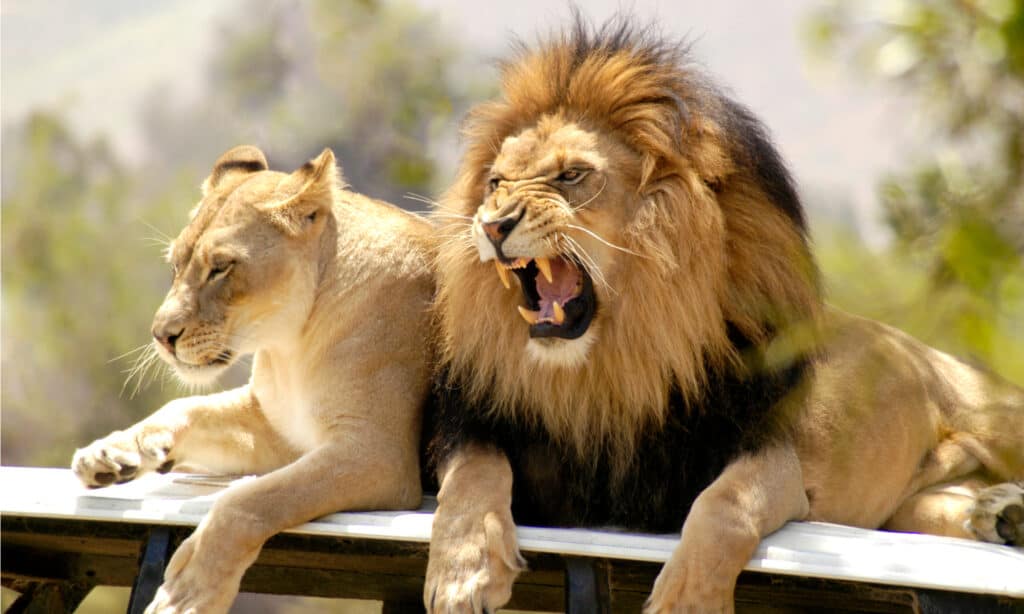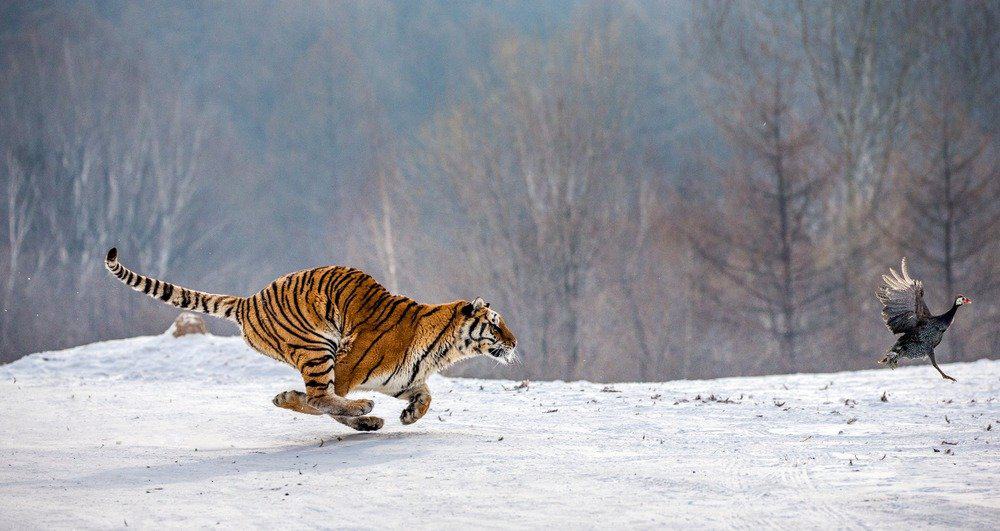Lions, bobcats, jaguars, tigers, and many other wild cat species dominate forests and jungles. The jaguar is considered among the most dangerous and deadliest predators in the Amazon Forest. On the other hand, the lion is dubbed the “King of the Jungle” for its huge and robust body, unparalleled strength, and impressive hunting skills. And the tiger ranks the largest among all cats on the planet. When it comes to the word “predators” of the jungle, wild cats will never miss the list. While various cat species are feared among the forest and other habitats for their heavy weights and hunting capabilities, there is not much said about dogs.
Dogs or canines may have wild dog species such as wolves and foxes, but their size, weight, and ability to impressively hunt their prey can not be compared to big cats. Huge dog breeds such as the Bernese mountain dog or St. Bernard are all breeds created and bred by humans from naturally existing canine species. On the other hand, cats have individual species, such as the tiger and the lion, that have bred and evolved on their own. So the question lingers, if there are big cats, why are there no big dogs? Below, we will find the answer to that and other fascinating facts!
If There Are Big Cats, Why Are There No Big Dogs?

There are big cats, but there are no big dogs because of the difference in the two animals’ hunting strategies.
©Gunther Allen/Shutterstock.com
The answer to that all goes down to one thing: hunting strategy. There are big cats, but there are no big dogs because of the difference in the two animals’ hunting strategies. Big cats usually hunt alone, relying on a quick burst of speed and snaps from their claws to catch their prey. On the other hand, wild dogs hunt uniquely, relying on teamwork and collaboration to pursue prey over vast distances until it passes out. In this type of endurance competition, a larger physique is a liability because it takes more energy to move about and doesn’t increase the chances of a kill.
All the huge dog breeds we see today being taken home as pets were generally formulated by man, created by cross-breeding natural and existing canine species. The original species that we know still lurk in the wild, such as wolves or dingos, are not big enough to topple and overpower massive cat creatures like lions or tigers. The large species of cats are all individual species that evolved naturally, increasing in size to adapt to the hunting opportunities and survival necessities in their environment.
There are no other natural canines that meet those criteria as well as the Big Cats. The timber wolf is the largest wolf, yet its stature pales compared to that of lions and tigers. The largest species of wolves can grow up to 137 pounds and 7 feet long, while tigers can reach 650 pounds and 12.5 feet in length.
How Do Cats and Dogs Hunt in the Wild?

Canines utilize their jaws to break bones and weaken their prey.
©Alan Jeffery/Shutterstock.com
Cats and dogs in the wild vary greatly when hunting their prey. Wild animals may induce fear in any mammal of flesh, even humans, but to survive an attack, you need to know which is hunting you first.
Felines rely on stealth and speed to survive, and canines have a high endurance level. Felines have acute, razor-sharp claws that may “snag” and drag down a fleeing animal. They can also disembowel their prey by shredding their victims with strong back claws. On the other hand, canines have blunt and rounded claws. In comparison, it’s not particularly lethal. They utilize their jaws to break leg bones, harm muscle, torment, and eventually weaken their prey to the point where they can attack.
Cats’ Hunting Behavior

Felines often use the stalk and pounce technique while hunting.
©GUDKOV ANDREY/Shutterstock.com
Have you ever noticed your cat stealthily stalking an insect or a lizard around your home? Or has your cat ever brought you a dead mouse or other dead critters they have hunted? There’s no need to freak out, though. Cats are natural predatory hunters, whether in the wild or not. Furthermore, their unique, impressive hunting behavior sets them apart from other animals.
Compared to other mammalian predators, big cats in the wild are known for their hunting ways and skills. Depending on the prey they seek, felines use a number of different hunting strategies, with one being used most often – the stalk and pounce technique. In cats, this is a well-known strategy. The cat locates its prey at the first stride, then stalks it, gently approaching it in a ground stance. If the prey moves away, the cat gradually approaches it, matching its speed to that of the prey. They collect their hind paws behind them and prepare for the powerful take-off when they’re ready to chase it down.
Dogs Hunting Behavior
The most distinguishing behavior of wolves when hunting is that they hunt in packs. Unlike felines, they use collaborative teamwork to take down their prey.
The wolf pack splits up and encircles its victim when hunting huge prey. Wolves commonly bite the shoulders and sides of their prey. While some pack members pursue the prey from behind, others seize the creature by the nose. A wolf pack is more than just wolves foraging together. They’re extremely complicated social groups with a clear hierarchy, social links, pack loyalty, and dominant pack leaders. Wolves may search for smaller prey on their own during peak prey seasons, but they will band together for safety and greater hunting success while hunting large and/or dangerous species. Members of the pack always benefit from it, and they frequently create very loyal social relationships with one another.
Canines prey drive is triggered by moving creatures’ sound, smell, or vision. Although hunting breeds have this intuition honed, even the most pampered domestic dog responds to the rustling of leaves, a leaping squirrel, or the scent of a bunny frozen in the shrubbery. The need to track and chase prey is as established in the canine mentality as feline hunting behavior is in the feline psyche.
What Happened to the Prehistoric Big Dogs?
Epicyon is a huge, prehistoric canid genus belonging to the Borophaginae subfamily and was native to North America for around 15 million years. Epicyon was a real “canid,” belonging to the same broad family as wolves and modern dogs. Its largest species weighed between 200 and 300 pounds, making them as big as, if not bigger than, a full-grown human and more than twice the size of a modern wolf. It had extraordinarily powerful jaws and teeth, making it look like a huge cat rather than a dog or wolf.
Epicyon haydeni, a monster beast larger than a dire wolf, a jaguar, and nearly as large as a modern-day African Lion, was an exception to the norm. These large prehistoric dogs weren’t really “dogs” or Canis at all. Borophaginae were pre-dogs, near-dogs, or dog-like creatures.
Growing into a massive size, the Epicyon soon evolved from hunting small prey to larger animals, making them compete with other larger species in the prehistoric period. Larger prey was less abundant, while the Canidae had plenty of smaller animals to feast on. Because of the Epicyon’s insanely strong jaws and specialized molars for crushing bone, they were known as “the bone crushers.” However, soon enough, there was not enough prey for the Epicyon and other huge predators, leading them to go extinct and letting the smaller Canidae family thrive.
The photo featured at the top of this post is © iStock.com/Shawn Levin
Thank you for reading! Have some feedback for us? Contact the AZ Animals editorial team.






